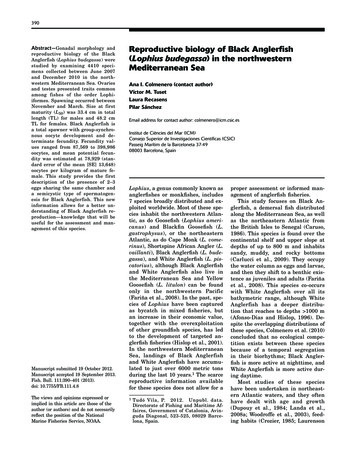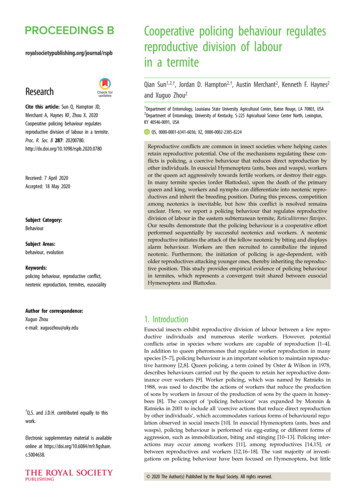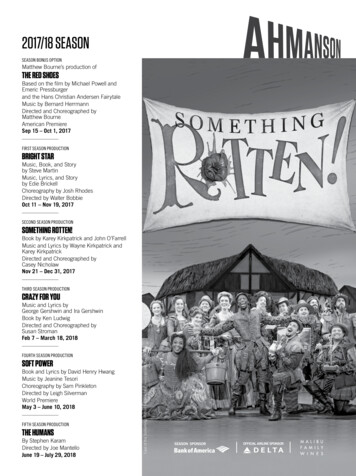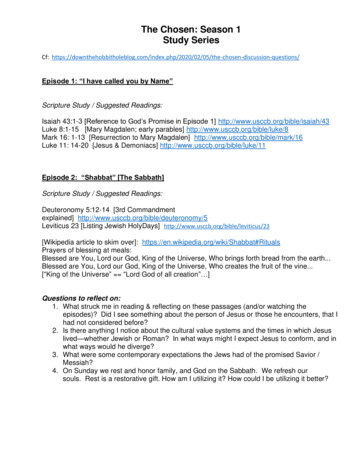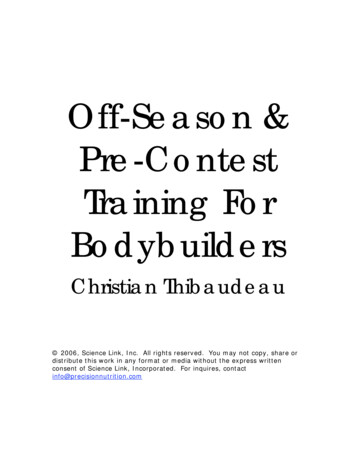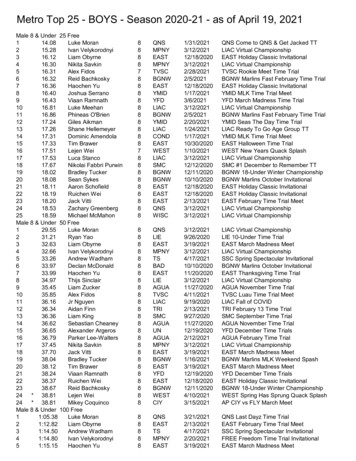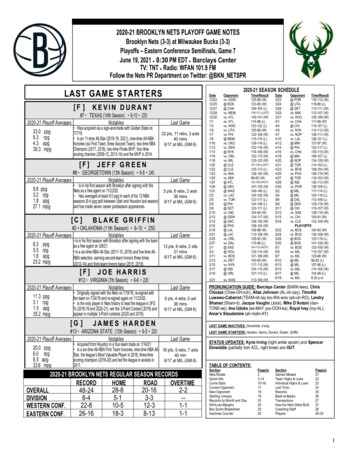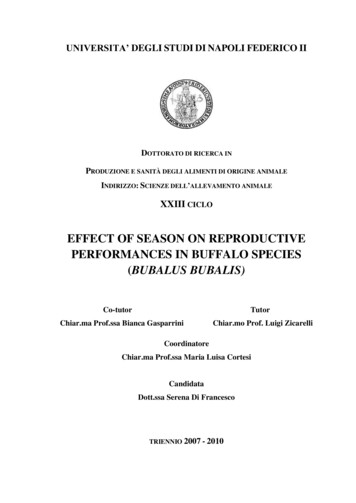
Transcription
UNIVERSITA’ DEGLI STUDI DI NAPOLI FEDERICO IIDOTTORATO DI RICERCA INPRODUZIONE E SANITÀ DEGLI ALIMENTI DI ORIGINE ANIMALEINDIRIZZO: SCIENZE DELL’ALLEVAMENTO ANIMALEXXIII CICLOEFFECT OF SEASON ON REPRODUCTIVEPERFORMANCES IN BUFFALO SPECIES(BUBALUS BUBALIS)Co-tutorTutorChiar.ma Prof.ssa Bianca GasparriniChiar.mo Prof. Luigi ZicarelliCoordinatoreChiar.ma Prof.ssa Maria Luisa CortesiCandidataDott.ssa Serena Di FrancescoTRIENNIO 2007 - 2010
I am strongly inclined to suspect that the mostfrequent cause of variability may be attributed tothe male and female reproductive elements havingbeen affected prior to the act of conception.Charles Darwin, The Origin of Species.To My Parents, My Sister, My Friends,To Bianca, Prof Zicarelli, My Colleagues.To Everyone who believed in me and still do.Serena2
INDEXpageINTRODUCTIONMediterranean Italian Buffalo 5Reproductive biotechnologies . 16Seasonality of reproduction .56GAMETESExperiment 1. Assessment of morphological quality anddevelopmental competence to in vitro embryo production (IVEP) ofoocytes throughout the seasons 66Materials and methods .67Statistical analysis 72Results .73Discussion 77Experiment 2. Evaluation of some parameters of sperm fertilitythroughout the seasons 84Materials and methods 88Statistical analysis 90Results .90Discussion 933
APPLICATIONS OF INNOVATIVE REPRODUCTIVEBIOTECHNOLOGIES TO BUFFALO BREEDINGExperiment 3. Artificial insemination (AI) performed in differentperiods of the year .100Materials and methods 102Statistical analysis 104Results .104Discussion .105Experiment 4. Ovum pick-up and in vitro embryo production (OPU IVEP) trials carried out during transitional period, spring-summerand autumn. .115Materials and methods 117Statistical analysis .121Results .121Discussion .126CONCLUSIONS 135REFERENCES 140ACKNOWLEDGMENTS .1654
INTRODUCTIONMediterranean Italian BuffaloBuffalo is an important economic resource for Italian animal husbandry,especially for the regions traditionally involved in the rearing of thisspecies. The largest concentration of heads can be found in Campania, inthe provinces of Caserta and Salerno, where 78% out of 400,000 animals ofItalian total amount of buffaloes is bred, but many farms exist also inLatium, in the provinces of Latina and Frosinone, and in Apulia. In theseareas, buffalo breeders have constantly grown both in professional andmanagerial terms, fine-tuning and perfecting breeding techniques andcoming to an efficient intensive or semi-intensive approach. In fact, inItaly, the type of farming has changed over time and the scheme withextensive use of meadows and pastures of the past has given way to anintensive farming, with free housing of the animals, modeled on that usedfor dairy cattle. Dairy buffaloes are kept loose in paddocks close to themilking room, where the cows are submitted to a rigorous control andcleaning of the udder, then mechanically milked twice a day. This advancemade the selection of subjects with the purpose of increasing productiveand genetic value possible, thus converting a marginal sector into an areawith great economic potential. In fact, this breeding has still a positive5
trend as it is demonstrated by several investments undertaken by manyentrepreneurs. Currently, there is a buffalo population growth of about70,000 animals per year, so the replacement of other species with buffalo isactually performed in many regions. This process is mainly due to themarked productive qualities, adaptability and rustic nature of the buffalo,on one side, but is also promoted –on the other hand- by a lowerenvironmental impact of this species: in fact, it was shown that buffaloeliminates a smaller amount of nitrogen with manure (54 kg vs. 81 kg/year)compared to dairy cow. This allows to increase the load of animals perhectare. Furthermore, in the total budget of a dairy farm, now more thanever, a careful balance between production costs and management costs isnecessarily required in order to keep market competitiveness. This,however, must not definitely affect the parameters that allow to obtain ahigh-quality raw material (milk), because it represents the starting point ofa peculiar and strictly linked product, such as mozzarella cheese, which hasnot only a traditional and cultural value in Italian gastronomy, but above allhas been providing employment for many years. In fact, it is worth tohighlight that nowadays, all around the world, consumers play a significantrole in demanding animal products that are produced to agreed standardsfor human health, environmental management and animal welfare.Moreover, in the areas mentioned above, the employment impact of this6
sector is estimated slightly higher than 5%: this can be considered arespectable value, considering that, in Campania, the employment impactin the sectors of agriculture and animal husbandry represents 3.8%,compared to a National value of 2.8% and 1% in Lombardia region.The importance and competitiveness of buffalo breeding in Italy, comparedwith the other more established forms of livestock rearing, is alsoconfirmed by the increase in the national buffalo population in the last tenyears ( 68.64%; source: ANASB1 data, 2008). The buffalo farming in Italyhas been reaching remarkable productive standards thanks to an intensework of selection and research carried out during the past years. The mostimportant business related to buffalo breeding is milk production, all ofwhich is processed into mozzarella cheese. The milk average productionrecorded in 2009 was over 2150 kg with peaks higher than 5000 kg perstandard lactation phase (270 days), with 8.39% fat and 4.61% proteincontent (source: ANASB statistical data, 2009; see Table.1) and withexcellent cheese making yields.1Associazione Nazionale Allevatori Specie Bufalina, i.e. National Buffalo Breeders' Association.7
Table. 1 Parameters regarding buffalo population and milk production in the last decadeAverage ,394,61288168,5(source: ANASB and Anagrafe Nazionale data)Since 1977 (year of the establishment of the Herd book of the species,which was managed by ANASB in close cooperation with the ItalianBreeders Association - AIA -) up to now, the average production increasedby about 600 kg per lactation and the percentage of fat and protein contentincreased from 6.4% and 4.3% to 8.4% and 4.7%, respectively. Theseproductive levels were achieved by the utilization of breeding systems thatbetter faced the nutritional requirements of the species. Moreover, thisenhancement was also due to the best knowledge of the potentialproduction of each buffalo, obtained by milk recording. In fact, the first8
step in the breeding and selection activity with regard to any dairy livestockis milk recording of the productivity of each yielding animal. The results ofmilk recordings, when appropriately merged with the genealogy data, allowa definition of the milk genetic merit of each individual, in particular of thebull, for which we have no other milk record except the production of hisrelated animals (Moioli et al., 2005). Furthermore, those functional controlsallowed not only the creation of the genealogical book of the species, anunique example in the World, but also to formulate the EMB (Equivalentmature buffalo) and the genetic indexes that lead a more careful selectionof the bulls. In 1988, progeny testing cycles on buffalo bulls were startedon the sons of the cows enrolled in the genealogical book. The geneticindexes were estimated by the Blup2 Animal Model method for thefollowing characters: production of mozzarella cheese (PKM), milkproduction (kg), fat and proteins production (kg and %). All therelationship to each bull (bull's mother, daughters under test) were ensuredby a PCR test on biological samples (blood, hair). The productions werecalculated out of 270 days of lactation (standard lactation) and heritabilityvalues for the estimation of animals‟ genetic value varied between 0.18 and0.14, slightly lower compared to those used for dairy cattle. All theseefforts spent in selecting a pure breed led in 2000 to the identification and2In statistics, best linear unbiased prediction (BLUP) is used in linear mixed models for the estimation ofrandom effects.9
admission by a Government decree of the “Mediterranean Italian Buffalo”breed, in order to distinguish it from other breeds which were not at thesame genetic level. This is a recognition of the peculiarities of the buffalopopulation bred in Italy: indeed, the Italian female buffalo can beconsidered exceptional in the international livestock raising scenario. In ourcountry, the profitability of this species is particularly linked to andguaranteed by a peculiar product such as “Mozzarella di Bufala Campana”cheese, that gained a very well defined profile in the market, enhanced andprotected by a Denomination of Protected Origin (DPO) trademark and,above all, is recognized in an increasing number of countries. Therefore,currently the selection is aimed to improve the production of mozzarella,which leads indirectly to improve the quantity and the quality of buffalomilk. So, in Italy, the commercialization of milk for mozzarella cheeseproduction represents the main income of buffalo breeding. This is acritical point for farm economy.However, meat production could also represent a good collateral profit. Infact, buffalo meat shows good quality characteristics according to the usualestimation parameters. In addition, the market interest in buffalo meat hasprogressively increased due to the negative trend towards bovine meatconsumption, which has very recently worsened due to the BSE concern. Inspite of the higher costs of buffalo meat production, due to their slower10
growth compared to specialized bovine breeds, there are sound reasons toexploit buffalo meat. For several years, rearing buffaloes for meatproduction has not been an attractive economic channel in our country. Thecauses of the low interest in this activity are many. In the past, whenextensive farming was still the most frequent way of rearing this species, itwas very common to find in the market meat of poor quality. Thisphenomenon occurred because the farmers paid little attention to thebreeding of males, whose management costs were higher than productiongains. Consequently, they were reared with small amounts of maternalmilk, reached the weaning weight of about 60-70 kg and thereafter wereleft out to pasture. The latter were often marginal pasture and, moreover,affected by the seasonal availability of fodder. This led the males to reachthe slaughter weight in about 3 years. Their meat was very tough andcharacterized by the smell of musk, derived from the habit of the animals tofind relief in puddles that they dig themselves into the ground. The gastrointestinal parasitic infestations and Pasteurella bubaliseptica operated anatural selection, on one side and slowed the growth of the survivingmales, on the other.Moreover, in the past years, when the meat came from buffalo calves in agood state of nutrition, was sold as bovine “beef”, otherwise it wasmarketed as buffalo meat. This fraudulent aspect has given rise a false11
notion in the consumer, difficult to eradicate. Therefore, the “market”image of buffalo meat, even if requested, was considered poor by theconsumer. All this helped to reduce the commercial value of buffalo meat.(Zicarelli, 2001).Nowadays, the change of EU agricultural policy, the greater awareness ofconsumers, together with the transformation of management techniques andthe continuous efforts by few farsighted farmers and entrepreneurs makethe buffalo breeding for meat very competitive. Many studies (Cutrignelliet al., 1996) ; Campanile et al., 2001a; Campanile et al., 2001b; Infascelli,2004; Infascelli et al. 2005) have reported that buffalo meat, when theanimal is properly bred to obtain meat, such as bovine beef, has someparticularly interesting nutraceutical features. It is worth to underline thatbuffalo meat is characterized by nutritional values better by far than otherkinds of meat and its calories content is lower than cattle meat. In fact, it ischaracterized by a low saturated fat content, a high protein level and a largepercentage of iron, as it is shown in Table 2.12
Table 2. Nutritional features of buffalo meat (100g) compared to other kinds of meat,available in Italian 0152OSTRICH24.02.0630105Source: MIPAF, National Research Institute for Food and Nutrition; http://www.inran.itAs for its digestibility and its good flavor, it is suitable to everyone,especially to children and old aged people. Moreover, table 2 also showsthat buffalo meat is low in cholesterol. It is well known that theconsumption of animal fats is discouraged by nutritionists, because it leadsto the increase of cholesterolemy. The latter, in fact, is mainly due tounsaturated / saturated fatty acid ratio. In buffalo meat, the impact ofsaturated fat is always lower (45-40%) than unsaturated
CIENZE DELL ’ALLEVAMENTO . recorded in 2009 was over 2150 kg with peaks higher than 5000 kg per standard lactation phase (270 days), with 8.39% fat and 4.61% protein content (source: ANASB statistical data, 2009; see Table.1) and with excellent cheese making yields. 1 Associazione .

